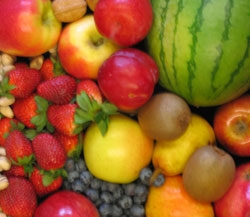
Americans, after years of hearing that fresh produce is valuable for numerous health benefits, have still not significantly increased their consumption. So, why don’t we eat more fruits and vegetables? Researchers believe that the key reason is that the quality of produce is inconsistent – often with poor texture, flavor or aroma. It might look beautiful on the outside, but when you take a bite – Ugh! It just doesn’t match up to its attractive exterior.
Most produce found at the local market is harvested from the field or orchard before it is fully ripe, shipped a long distance, and then the ripening is completed at a regional produce distribution center or at the local market.
“Harvesting produce early reduces losses due to bruises, decay and other defects,” explained Beth Mitcham, SCRI Grant UCD project leader, “but oftentimes the product never reaches its potential, a full ripe flavor or aroma. Fresh produce, especially when harvested near full ripe stage, can be challenging to handle properly.”
The SCRI grant is an ambitious effort to understand what characteristics are critical for consumers to enjoy produce and develop better methods to measure flavor quality, then work with better tasting varietals and improved shipping and handling practices to allow economically viable delivery of truly delicious fruits and vegetables.
Consumer focus groups are being interviewed for their input, trained taste panels are enjoying a variety fresh produce, and experiments with pallet shrouds and other modified atmosphere transportation experiments are underway. Significant information has already been elicited from consumer groups. Through focus groups, the investigators have discovered that aroma and texture are nearly as important as sweetness, and shoppers get really irritated when produce looks good but tastes bad, and this keeps repeat purchases to a minimum.
Produce managers also have a tough time: set up displays of produce, keep it at the right temperature, watch people wandering around squeezing everything to see if their firmness requirements are met, meanwhile damaging the fruit. It’s a tough market for fresh fruit these days, with fewer consumers’ dollars allocated for produce purchases, but with the advances researchers are making through the SCRI project and others, sweet success is on the way.
Note: This topic was featured on a CBS13 (KOVR) News clip dated 7/17/10, see: http://www.cbs13.com/video/?id=76639@kovr.dayport.com
